Myth of the Barricade:
The barricade is the myth of insurrection. To look back at past revolt is to reflect on the use of barricades. To see struggle today is to watch the burning barricades of the Paris banlieues, the walls of flame in Athens, the camp fires of the Native roadblock. A barricade consciousness was born in myth and spread as a symbol.
Anticipation of the future takes the form of those myths which enclose the strongest inclinations, which occur in the mind with the insistence of instincts in all circumstances of life; and which gives an aspect of complete reality in the hopes of immediate action.
The myth of the barricade is a body of images capable of invoking instinctively, all the sentiments which correspond to the different manifestations of social rebellion.
As a symbol it has transmitted through centuries of defeat but still retains its redemptive agency. At the barricade, present struggles need not be overloaded with prior sufferings but leap back and grasp a past moment of insurrection, to give it new life and achieve today what once failed. It is within the potentiality carried in every moment that every insurgent barricade awaits its return.
From riot to insurrection the barricade is a constant. In the first awakening moments of the riot, the barricade appears immediately, made from dumpsters, torched cars, rubble, prison mattresses –whatever is at hand. Often the style of the barricade projects the trajectory of the riot.
Barricades of adaptation and diffusion can be instantly reproduced, even when decades have eclipsed since their last appearance. They are a template to enable, with minimal discourse or organizational continuity, coordinated points of rupture. These elements constitute the barricade consciousness.
Insurgent-Assemblage:
The barricade made of single objects working in cooperation with one another operates as an assemblage. The characteristics of the barricade-assemblage are the flowing, breaks and swerves of its autonomous components. This is opposed to the closed connections of the state apparatus that regulates networks of power. The barricade assemblage corresponds to a tendency of permanent connection –it reaches outwards to establish an infinite plain of consistency. The barricade is a node of spreading revolt, communicating and connecting to other modes of struggle. It flows from one street (or forest road) to the next; when it is restricted, it goes underground and links up again in a rhizome. Finally the street engulfs the city, as on the land –the industrial ruins are re-wilded.
Following the Barricade Wars of 1848 which swept Europe, the streets of Paris and other major city’s where demolished and replaced with vast boulevards, so as to prevent the use of barricades in future combat. At this time even Blanqui called for an end of the insurgent barricade claiming that they where stupid and a waste of time as they prevented the free movement of insurgents. A short while later in 1871, in a great leap forward for the adaptability of barricade consciousness, the barricades of the Paris Commune traversed the street to occupy the whole city.
The barricade fighting that took place during the Commune was fought more from the windows above in the buildings connected to the barricades. The barricade became the tissue that interconnected the street to the fighter to all structures.
The insurgent with their projectile constitutes a war machine under the conditions of the barricade: functioning as a component part in conjunction with other parts. In this, the insurgent barricade rejects any closed-circuit specificities and instead opens itself to a pure means, which demands nothing and occupy’s everything. There the rebel-subjects integrated with the barricade, in both myth and structure –intermingle as singularities in becoming…whatever.
‘Elsewhere, behind the hastily improvised barricades erected and set alight by local kids in back streets they prepare to greet their daily enemy – the cops in their anti-riot vans – with a hail of bottles and stones…’ August 2011 Revolt: Anarchy in the UK
Solidarity Means Attack:
A barricade not only cuts across vast periods of time (appearing in the same place again), but also carries across vast distances (appearing at different places at the same time). As a mechanism of solidarity, it best represents that the
best solidarity is to attack. Dealing with multiple barricades draws the state into many fronts and relieves one front for attracting the full blunt.
During the ‘stand off’ at Oka there where dozens of barricades across turtle island, with British Columbia (BC) erecting the most. This was the basis of the sentiment of Mohawk indigenous warrior Donna Goodleaf:
‘No doubt, their tactic of blockading railway lines proved to be a necessary and effective tactic of resistance to ensure that no military or state police would commit racial genocide against my people’.
The multitude of barricades which blossomed from the Oka uprising and that spring-up spontaneously across vast areas during times of crisis, offer not simply maps of revolt, but a cartography revealing lines of flight from empire.
A Beautiful Storm:
‘Blockades, being scattered are very disruptive and hard to regulate. When several are in place at he same time, the effect can be striking. As one is resolved, another emerges; much as do the forest fires that flare up across the BC interior as the summer storms sweep across the mountains.’
The barricade, as signifier of ruin, is the mystical expressind-color: black; color: #b0b0b0; font-family: Verdana, Arial, sans-serif; font-size: 12px; line-height: 19px; text-align: left;">
A re-territorialisation swirls beyond the blockade, placing its zone outside the state, and if the blockade exists in absolute antagonism against the state then the rebel-subjects find the greatest strength in the common-ing of life together. The insurgent singularities become a community so long as their power circulates and the blockade is that of a community-in-movement.
During indigenous blockades there is the assertion of sovern society against the state (that is when the blockade is not a ruse of the band council). The metropolitan blockade is an occupation of space –that’s subversion was understood at the disruptive climax of the global Occupy rupture (that i, Arial, sans-serif; font-size: 12px; line-height: 19px; text-align: left;">
Counter-Power:
Barricades are born not only from spontaneity but are also a common mechanism in establishing and maintaining counter-power. In extracting their needs from the state, insurgents will threaten with the specter of the barricade to haunt capital into negotiating, or will construct the barricade to force the state to sue for peace. This barricade piracy is a constant in parts of Argentina. A social force known as the Piqueteros (the term reference to their tactic of road blocks), has been barricading highways since the mid-90’s; demanding jobs, healthcare, money, ect.
‘We see the way capitalism operates is through the circulation of goods. Obstructing the highways is the way to hurt capitalists the most. Therefore we who have nothing, our way to make them pay the cost, and show them that we will not give up and die for their ambitions, is to create difficulties by obstructing large routes of distribution.’
In Argentina at points of crisis, the militant practice of the piqueteroshas generalized across society, with the barricade becoming the manifestation of the categorical demand.
Blockade Everywhere:
If the barricade is the blocking of capital and command then the blockade is the threshold from where those relations to capital and command are severed and wither away. It is the zone of transformation, passage and flight; the blockade is life lived behind the barricades; it is the abolition of domination in our every day life.
In the reversal of traditional military statecraft –the logic of blockading a hostile enemy –the insurgent declares them selves to be hostile and in-turn violently resists the states interventions and commodity reification.
Whereas the barricade is constructed, the blockade is constitutive.
A re-territorialisation swirls beyond the blockade, placing its zone outside the state, and if the blockade exists in absolute antagonism against the state then the rebel-subjects find the greatest strength in the common-ing of life together. The insurgent singularities become a community so long as their power circulates and the blockade is that of a community-in-movement.
During indigenous blockades there is the assertion of sovern society against the state (that is when the blockade is not a ruse of the band council). The metropolitan blockade is an occupation of space –that’s subversion was understood at the disruptive climax of the global Occupy rupture (that is when the Occupy was not a ruse of activists). Keep ever green the memory of the Oakland Commune, how it was both an occupation-in-motion and a nomadic blockade: painted on the shields at the front of the mobile street barricade was the call, ‘Commune move in’ & ‘Cops move out’
Blockades find their consistency not just in the ability to maintain their barricades –but also in extending the blockade to include all aspects of life. From hunting to food gathering, ghosts dances to drum circles, armed defense to social rebellion, long houses to tent city’s, warrior societies to mutual aid societies.
The subject of the strike is no longer the working class as such, though workers are always involved. The strike no longer appears only as the voluntary withdrawal of labor from the workplace by those employed there, but as the blockade, suppression, (or even sabotage or destruction) of that workplace by proletarians who are alien to it and perhaps to wage-labor entirely. Blockading the Port is Only the First of Many Last Resorts: Oakland 2012
Sabotage:
To remain ungovernable the blockade intensifies its disruption by diffused sabotage. Sabotage must correspond with the everyday life lived in the blockade. In Eco-blockades the machinery of dominion is dismantled. In the metropolitan blockade the institutions of control are attacked. It was from Tahrir Square that every copshop, courthouse and government building in Cairo was ‘fired’.
The science of sabotage and the generalization of war-knowledge presuppose the centrifugal spread of revolt.
“We have blocked a major highway in Mexico State with a barricade made by the Luddites Against Domestication of Wild Nature. The fire lit up the dark night of peace and tranquility for those people who carry in large trucks ‘raw materials’ extracted directly from the earth. The chaos was again before the eyes of the police who arrived on the scene to put out the incendiary fiesta. We break their precious social order with our wild, insurgent and radical methods of struggle.”
Capture/Rupture:
In 1872 the first blockade in occupied BC occurred when the Gitxsan blockaded the Skeena River, preventing genocidal settlers from traveling. 100 years later was BC’s first armed blockade, on Bonaparte Reserve. The next year the Tl’azt’en blockaded a railway for 3 months. In the following few months there where at least 13 more blockades throughout the province.
The spread of barricade consciousness always follows logistical sense: ‘Part of the reason road and railway blockades are so commonly used by natives in BC is proximity; many reserves are located near or beside the roads, highways and/or rail lines –which are a common point of conflict as they are reserve lands expropriated by the government.’ In a chronology of such barricades in BC, put together by Zig-Zag, there where a total of 101 between 1984-2006.
Zig-Zag makes the distinction between grassroots direct action and the tactics of civil disobedience sanctioned by Band Councils:
‘ At times, roadblocks form part of a larger political and public relations campaign. Often the band and tribal councils sanction roadblocks. Because of their approach, or due to their relationship to the colonial governments and businesses, campaigns carried out under band councils tend to receive far less state repression’
But the power that the blockade represents can not be captured. Even such structured events signal the epoch of uncontrollability. Hear the fear of this becoming in a commentary written in the Vancouver Sun by a political science professor at the University of BC:
‘… But these blockades and arrests were carefully orchestrated; the RCMP worked closely with the natives. The natives wanted to get arrested to press their point. In those cases there was never a threat of violence, like there is on the Douglas Lake Road (’95). The use of masks is significant. That’s Oka…I deplore this development. This use of masks is a symbol we don’t want in BC’.
For the blockade to be insurrectionary it must explode collaboration. When used by collaborators more times then not it does explode in their faces. This lesson of fires nature to spread –which has led to the retreat from the woods by the Environmental NGO apparatus, is perfectly exemplified by the Elaho blockade of 2001. The environmentalists quickly lost their control to the black masked anarchist-horde, and as a result offered a bounty on the head of tree spikers and worked directly with the RCMP. This had no affect on the anarchists whose living-wild and subsequent use of barricades and consistent sabotage ended the logging of a massive corporation.
The blockade retains no inherent agency; an ethical tissue must grow from and intertwine throughout the community-in-motion. In Oaxaca during the Commune of 2006, which lasted 7 months and erected over 3000 barricades, the failure of the insurrection would not have been a given, if, as reported by Barucha Calamity Peller,
‘the sexual division of labor was openly confronted and did not disable women’s ability to hold the barricades and occupations.’
The insurgent blockade is the line of demarcation in this global civil war that cuts through us all. Before one can choose what side of the barricade they are on, they must determine which sides the blockade opposes with enmity.
‘…However, the Oaxaca Commune and its barricades and occupations, its street battles and long nights of assemblies, all running on the blood and sweat of women’s resistance, continues to inspire the possibility of insurrection and mass popular revolt. The state of ‘ungovernability’ which the movement claimed was meant as true freedom, and the rebellious women of the movement refused, for a time with great force, to be governed by state authority, by the domination of capitalism in its everyday manifestations, by husbands, middle class women, or by the police.’
> > >
Any closing remark fails us, as the urgency remains in the streets and in the wild spaces. As the potential for new blockades increase, so does our joyful anticipation for the meeting of new friends behind the barricades.

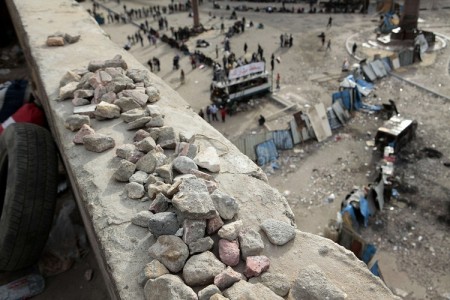

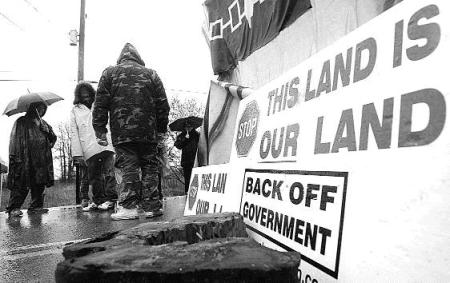
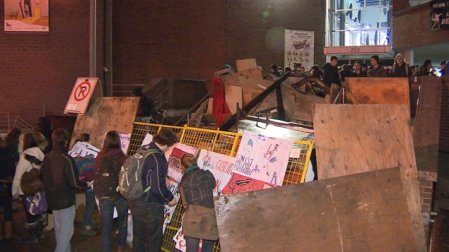
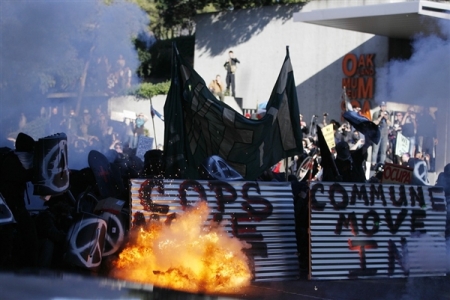





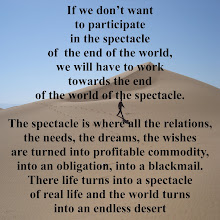


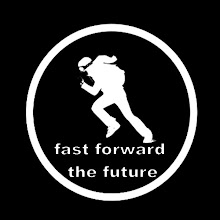




No comments:
Post a Comment